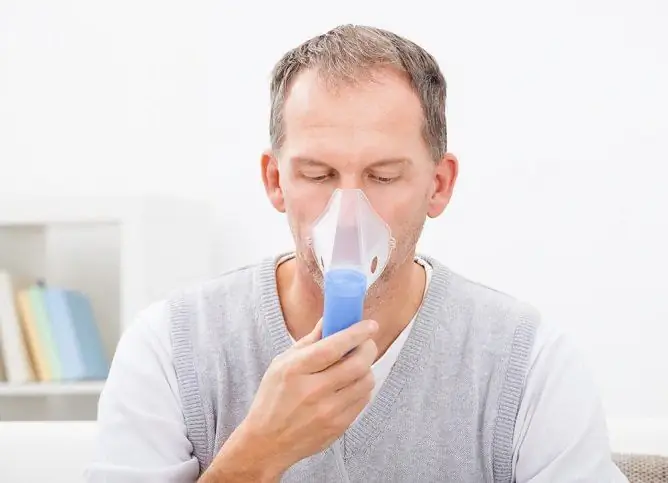Budesonide-native
Budesonide-native: instructions for use and reviews
- 1. Release form and composition
- 2. Pharmacological properties
- 3. Indications for use
- 4. Contraindications
- 5. Method of application and dosage
- 6. Side effects
- 7. Overdose
- 8. Special instructions
- 9. Application during pregnancy and lactation
- 10. Use in childhood
- 11. In case of impaired renal function
- 12. For violations of liver function
- 13. Use in the elderly
- 14. Drug interactions
- 15. Analogs
- 16. Terms and conditions of storage
- 17. Terms of dispensing from pharmacies
- 18. Reviews
- 19. Price in pharmacies
Latin name: Budesonid-nativ
ATX code: R03BA02
Active ingredient: budesonide (Budesonide)
Manufacturer: Pharmstandard-UfaVITA OJSC (Russia), Nativa LLC (Russia)
Description and photo update: 2019-08-07
Prices in pharmacies: from 313 rubles.
Buy

Budesonide-native is a glucocorticosteroid (GCS) for topical use.
Release form and composition
The drug is produced in the form of a solution for inhalation: colorless or slightly yellowish liquid, slight opalescence is possible (2 ml each in colorless glass vials, 10 vials together with instructions for the use of Budesonide-native are placed in a cardboard box).
Composition of 1 ml solution:
- active substance: budesonide - 0.25 or 0.5 mg;
- auxiliary components: propylene glycol, disodium edetate (Trilon B), succinic acid, macrogol 400 (polyethylene oxide-400), methyl parahydroxybenzoate (nipagin), purified water.
Pharmacological properties
Pharmacodynamics
Budesonide is a synthetic corticosteroids, which has antiallergic, anti-inflammatory and immunosuppressive effects in the bronchi.
In an in vitro study conducted in animal models, budesonide demonstrated 200 times the affinity for glucocorticoid receptors and 1000 times more pronounced anti-inflammatory effect than cortisol.
Budesonide-native increases the formation of lipomodulin (an inhibitor of phospholipase A), inhibits the release of arachidonic acid and suppresses the synthesis of its metabolic products [prostaglandins (Pg) and cyclic endoperoxides], inhibits the migration of macrophages and the release of inflammatory mediators from mast cells, reduces the production of cytokines and inflammatory prevents marginal accumulation of neutrophils, reduces the formation of chemotaxis substance and the intensity of infiltration processes.
Budesonide increases the number of "active" β-adrenergic receptors. Normalizes the reaction of the bronchi to bronchodilators, which reduces the frequency of their use. Improves mucociliary transport. Reduces mucus production and sputum formation, edema of the bronchial mucosa and airway hyperreactivity, thereby reducing the severity of symptoms of bronchial asthma, the frequency of exacerbations of the disease and the frequency of side effects in comparison with the use of systemic GCS
Budesonide-native does not show mineralocorticosteroid activity, is well tolerated with prolonged use. In therapeutic doses, it has almost no systemic effect.
Improvement in lung function is noted several hours after inhalation of a single dose. The maximum therapeutic effect develops within 1–2 weeks, in some patients - after 4–6 weeks.
Compared to prednisone 10 mg, budesonide at the recommended doses has significantly less effect on adrenal function.
Pharmacokinetics
- absorption: after inhalation, only ⅓ part of the budesonide that entered the alveoli is absorbed, the rest is deposited on the mucous membrane of the oropharynx and is swallowed. Bioavailability is 15% of the total dose, 40–70% of the delivered dose. The maximum plasma concentration (C max) is observed 30 minutes after inhalation;
- distribution: budesonide binds to plasma proteins by 85–90%. There is practically no connection with corticosteroid-binding globulin. Penetrates into breast milk. The volume of distribution (V d) is about 3 l / kg;
- metabolism: a part of the drug that has entered the gastrointestinal tract is absorbed and almost completely (85–95%) is metabolized in the liver with the participation of the CYP3A4 isoenzyme to form metabolites of 6β-hydroxy-budesonide and 16α-hydroxyprednisolone, which have low glucocorticosteroid activity (less than 1% activity of budesonide);
- excretion: excreted in feces and urine in the form of metabolites / conjugates, a small amount of the drug is excreted unchanged. Budesonide has a high systemic clearance (~ 1.2 L / min). The half-life (T ½) is 2–3.6 hours.
The pharmacokinetics of budesonide is directly proportional to the size of the administered dose.
Differences in the characteristics of native budesonide in patients of different sex, age and race were not revealed.
There are no data on the pharmacokinetic parameters of budesonide in patients with hepatic and renal insufficiency. With liver diseases, it is possible to increase the duration of the presence of the drug in the blood plasma. There is a dose-dependent effect of budesonide on cortisol levels in blood plasma and urine.
Indications for use
- bronchial asthma (BA), requiring maintenance therapy with GCS;
- chronic obstructive pulmonary disease (COPD).
Contraindications
Budesonide-native solution for inhalation is contraindicated in children under 16 years of age and in all patients with hypersensitivity to its components.
The drug should be used with caution in patients with bacterial, viral and fungal infections of the respiratory system, active form of pulmonary tuberculosis, cirrhosis of the liver, as well as in pregnant and lactating women.
Budesonide-native, instructions for use: method and dosage
Budesonide-native solution can only be used with a nebulizer.
The doctor selects the optimal daily dose individually. If it does not exceed 1 mg, it can be inhaled entirely at a time. Higher doses should be divided into 2 applications.
Initial daily doses:
- adult patients, including the elderly: 1–2 mg;
- adolescents from 16 years old: 0.25–0.5 mg, depending on the clinical picture, the dose may be increased to 1 mg.
Maintenance daily doses:
- adults, including elderly patients: 0.5-4 mg, in severe cases, the dose is increased;
- adolescents from 16 years old: 0.25-2 mg.
The required volume of solution, depending on the prescribed dose of Budesonide-native:
- dose 0.25 mg: drug 0.25 mg / ml - 1 ml *;
- dose 0.5 mg: drug 0.25 mg / ml - 2 ml;
- dose 0.75 mg: drug 0.25 mg / ml - 3 ml;
- dose of 1 mg: drug 0.25 mg / ml - 4 ml or drug 0.5 mg / ml - 2 ml;
- dose of 1.5 mg: drug 0.5 mg / ml - 3 ml;
- dose 2 mg: drug 0.5 mg / ml - 4 ml.
* Should be diluted with 0.9% sodium chloride solution to a volume of 2 ml.
After the desired effect is achieved, all patients are reduced the dose to the minimum effective dose that allows maintaining a stable state.
Supportive care is desirable at the lowest effective dose.
If it is necessary to achieve an additional therapeutic effect, instead of a combination with oral corticosteroids, an increase in the daily dose of native budesonide (up to 1 mg) may be recommended, since in this case the risk of systemic effects is lower.
When transferring a patient to Budesonide-native for inhalation from oral corticosteroids, the latter should be canceled during a period of stable condition. During the first 10 days, Budesonide-native is prescribed in a high dose simultaneously with oral corticosteroids in the usual dose. Over the next month, the dose of corticosteroids is gradually reduced (for example, 2.5 mg of prednisolone or its analogue) to the minimum effective. In many cases, the GCS can be completely abandoned.
Instructions for using the drug
Budesonide-native solution should be applied using a nebulizer equipped with a mouthpiece and a special mask. The nebulizer is connected to the compressor to create the required air flow (ranging from 5 to 80 l / min). Its filling volume should be 2–4 ml.
Rules for using the drug:
- Open the bottle with the solution.
- Fill the nebulizer with the required amount of the drug through the upper hole.
- Perform inhalation in accordance with the instructions for the nebulizer. When using a mask, make sure that the mask is snug against the face when inhaled. When inhaling, the drug enters the lungs, so it is important to inhale it through the mouthpiece calmly and evenly.
- Store an open bottle in a dark place for no more than 12 hours.
- After each use, clean the nebulizer chamber and mouthpiece or mask with a mild detergent and warm water according to the manufacturer's recommendations.
- After use, rinse and dry the nebulizer well by connecting the chamber to a compressor or air inlet valve.
Important notes:
- carefully read the instructions for use of Budesonide-native and nebulizer before use;
- budesonide solution diluted with 0.9% sodium chloride solution, store no more than 30 minutes;
- after inhalation, rinse your mouth with water to reduce the risk of developing oropharyngeal candidiasis;
- after inhalation, rinse your face with water to avoid skin irritation;
- regularly clean the nebulizer in accordance with its instructions for use.
Side effects
From the side of various organs and systems of the body, the following side reactions may occur (according to the frequency of occurrence, they are classified as follows: often - from ≥ 1/100 to 1/10 000 to <1/1000, very rarely - <1/10 000):
- from the respiratory system: often - moderate irritation of the mucous membrane of the throat, candidiasis of the oropharynx, dry mouth, hoarseness, cough; rarely - bronchospasm;
- on the part of the organ of vision: very rarely - glaucoma, cataract;
- from the gastrointestinal tract: rarely - nausea;
- from the nervous system: rarely - behavioral disturbances, excitability, nervousness, depression;
- on the part of the immune system: rarely - hypersensitivity reactions of an immediate and delayed type, including skin rashes, urticaria, contact dermatitis, bronchospasm, angioedema, anaphylactic reaction;
- from the skin and subcutaneous tissues: rarely - facial skin irritation, bruising on the skin;
- others: very rarely - a decrease in bone mineral density.
In rare cases, there are disorders caused by the systemic action of Budesonide-native, including hypofunction of the adrenal glands and growth retardation in children. The severity of these complications depends, presumably, on the dose of the drug, the duration of treatment, concomitant or previous use of GCS, individual sensitivity to budesonide.
Overdose
In cases of acute overdose, clinical manifestations were not identified.
With prolonged use of Budesonide-native in excessive doses, there is a high risk of developing a systemic glucocorticosteroid effect.
special instructions
Budesonide-native is not intended for the relief of acute episodes of asthma and COPD. Prophylactic use of the drug in bronchial asthma prevents attacks, but is not able to stop acute bronchospasm.
Inhalation should be carried out with caution, following the instructions for use of the nebulizer and avoiding contact with the eyes. After each inhalation, it is recommended to rinse the mouth with water to reduce the risk of developing candidal stomatitis.
Budesonide-native has been shown to be effective in preventing exercise-induced bronchial asthma.
Due to the risk of weakening the function of the adrenal glands (hypocorticism), special observation is required for patients who are transferred to Budesonide-native from oral corticosteroids. It is also necessary to control patients who received high-dose GCS or long-term inhaled GCS at the maximum recommended doses. In stressful situations (for example, during surgery or trauma), such patients may develop adrenal insufficiency. In stressful conditions and in cases of surgical interventions, additional use of systemic GCS is recommended.
Patients who are transferred to Budesonide-native from systemic GCS, as well as patients at risk of impaired pituitary-adrenal function, need special supervision. In these cases, it is necessary to carefully reduce the dose of systemic corticosteroids and carefully monitor the hypothalamic-pituitary-adrenal function. During stressful situations, additional use of oral corticosteroids may be required.
When switching from oral corticosteroids to budesonide-native, patients may experience previously observed symptoms, such as pain in joints and muscles. Under these circumstances, a temporary increase in the dose of oral corticosteroids is required. In rare cases, disorders such as nausea, vomiting, headache, and feeling tired are observed. They indicate systemic insufficiency of glucocorticosteroids.
Sometimes, replacing oral GCS with inhaled ones can lead to the development of concomitant allergies (rhinitis, eczema), which were previously stopped by a systemic drug. In rare cases, there is an exacerbation of the existing Churg-Strauss syndrome, the development of hemorrhagic vasculitis or eosinophilia, as well as a worsening of pulmonological symptoms not associated with the transition to budesonide.
The systemic effects of inhaled corticosteroids are manifested mainly when high doses of the drug are used for a long time. The risk of their occurrence is much lower than when taking oral corticosteroids. Possible systemic effects: suppression of adrenal function, decreased bone mineral density, glaucoma, cataracts, growth retardation in children and adolescents. For this reason, an important condition is careful titration of the native budesonide dose to the lowest effective dose that allows adequate control of the disease. In children who have been receiving the drug for a long time, it is recommended to regularly measure growth. In case of growth retardation, it is necessary to correct the treatment regimen in the direction of reducing the dose of native budesonide to the lowest effective dose.
It is recommended to avoid concomitant use of CYP3A4 inhibitors, including itraconazole, ketoconazole and other potential inhibitors of this isoenzyme. If the need for a combined prescription of drugs is clinically justified, the intervals between doses of drugs should be maximized or the possibility of reducing the dose of native budesonide should be considered.
Budesonide does not interfere with doping control test results.
Influence on the ability to drive vehicles and complex mechanisms
No studies have been conducted on the effect of native budesonide on psychomotor and cognitive functions. Patients who experience adverse reactions in the form of hyperkinesia or bronchospasm are advised to refrain from driving and performing potentially hazardous work that require quick reactions and increased attention.
Application during pregnancy and lactation
In the course of clinical studies of the use of budesonide during gestation, developmental abnormalities in the fetus were not detected, but the risk of their occurrence cannot be completely excluded. To avoid aggravation of the course of bronchial asthma during pregnancy, Budesonide-native should be used in the minimum effective dose.
There is evidence that budesonide is able to pass into breast milk. Therefore, during lactation, Budesonide-native can be prescribed only after a careful assessment of the expected benefits and possible risks.
Pediatric use
Budesonide is not indicated for the treatment of children and adolescents under 16 years of age.
With impaired renal function
There is no data on the use of native budesonide in patients with renal insufficiency.
For violations of liver function
With caution, Budesonide-native should be used by patients with liver cirrhosis, since they may have an increase in the duration of the drug, which is due to the excretion of budesonide by biotransformation in the liver.
Use in the elderly
There are no special instructions on the dosage regimen of Budesonide-native for elderly patients.
Drug interactions
In bronchial asthma, Budesonide-native combines well with β 2 -adrenomimetics, methylxanthines, nedocromil, cromoglycic acid preparations, ipratropium bromide. Pre-inhalation of β 2 -adrenomimetic dilates the bronchi, which improves the flow of budesonide and enhances its effect.
The effectiveness of native budesonide is reduced by rifampicin, phenytoin, phenobarbital and other inducers of microsomal oxidation.
Plasma concentration of budesonide increases with the simultaneous use of estrogens or methandrostenolone.
The CYP3A4 inhibitor ketoconazole, administered 200 mg once a day, increases the plasma content of budesonide taken orally at a dose of 3 mg by an average of 6 times. When taking ketoconazole 12 hours after budesonide, the plasma concentration of the latter increases 3 times. There is no information on such an interaction with inhaled forms of budesonide, but a noticeable increase in its plasma level is expected. Similar reactions are expected when combined with itraconazole and other potential inhibitors of the CYP3A4 isoenzyme.
Analogs
Analogues of Budesonide-native are: Alvesco, Asmaneks Twistheiler, Beklospir, Beklazon Eco, Beklazon Eco Light Breathing, Budoster, Benacort, Budenit Steri-Neb, Pulmicort, Klenil, Fluticason, Flixotide, etc.
Terms and conditions of storage
Store in a dark place at temperatures up to 25 ° C. Keep out of the reach of children.
The shelf life is 3 years.
Terms of dispensing from pharmacies
Dispensed by prescription.
Reviews about Budesonide-native
The advantages of the drug include a relatively low cost and convenient packaging (separate bottles). There are few positive reports of drug efficacy. Basically, on specialized sites and forums, there are negative reviews about Budesonide-native. In them, patients indicate a pungent odor of the solution, drug intolerance and the development of an even greater cough. As many report, the very first breath caused an attack of the strongest prolonged cough in them, some developed obstruction. In this regard, patients consider it impossible to use Budesonide-native, advise not to save on treatment and buy a branded proven remedy on their own (for example, Beklazon Eco, Pulmicort or Budenit Steri-Neb). There are also complaints of other side effects such as dizziness and nausea.
The price of Budesonide-native in pharmacies
The approximate price for Budesonide-native for a package of 10 bottles is: dosage 0.25 mg / ml - 308 rubles, dosage 0.5 mg / ml - 345-390 rubles.
Budesonide-native: prices in online pharmacies
|
Drug name Price Pharmacy |
|
Budesonide-native 0.25 mg / ml solution for inhalation 2 ml 10 pcs. 313 r Buy |
|
Budesonide-native 0.5 mg / ml solution for inhalation 2 ml 10 pcs. RUB 319 Buy |

Anna Kozlova Medical journalist About the author
Education: Rostov State Medical University, specialty "General Medicine".
Information about the drug is generalized, provided for informational purposes only and does not replace the official instructions. Self-medication is hazardous to health!







